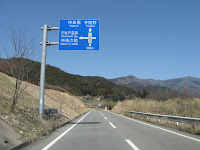There are actually a few more people in the building: some teachers who have offices elsewhere in the school, as well as the office staff. But it's ridiculous that anyone has to be at school. I have a sheet listing everyone who works here and, according to my count, only 18 of 47 of them are here today. Tomorrow, that number drops to 14. Needless to say, but I'll say it anyway, I'll be taking an extended lunch break today. And tomorrow. Go figure.
OK, now that I've gotten that out of the way...
Last Friday I had the pleasure of dressing up as Santa Claus, better known around these parts as "Santa-san," and visiting a local kindergarten. I guess you could say that's one of my jobs as one of only three foreigners living in town. My supervisor told me I was dressing up as Santa so I was dressing up as Santa. I'm sure I could have begged out of the assignment, but I was more than happy to oblige.
One perk of the assignment is that I didn't have to show up for "duty" at the community center-like pl
 ace down the street from where I live until 9:30 a.m. Since going to school before that didn't make much sense, I got to sleep in. Hooray for Santa!
ace down the street from where I live until 9:30 a.m. Since going to school before that didn't make much sense, I got to sleep in. Hooray for Santa!Another perk of the assignment is that I was originally told to show up on December 12th, by mistake. Which meant that day I also got to sleep in and didn't get to school until around 10 a.m. Santa rules!
Just about the funniest thing about that December 12th mix-up is that when I called my supervisor to tell him something was amiss, he told me I was in the wrong place. So he came to rescue me, took me to the right place, and was then told that Santa wasn't supposed to arrive until until the 21st. Ta da! That's when I told my supervisor, "I'm not as dumb as you look." (Luckily, we get along great!)
The funniest thing about that December 12th mix-up was how I scored a free can of hot coffee.
There I was, standing on the edge of Gokase's "Union Square" (I'll have to come up with a better name for it later, but that's what I call the "heart" of this village, the parking lot in front of the "big" grocery store), waiting patiently for my supervisor to come to my rescue, when this man in the parking lot started motioning toward me.
At first, I thought, "Oh, this must be the guy I'm supposed to go find." But then I thought, "No, no chance. I think he needs some help with something." So I gave him this look like, "Yeah, sure man, what do you need?" And then he sta
 rted motioning more to me as if he needed help carrying something perhaps. And then I think he signaled to his buddy that he had found someone for the job. And then he signaled back to me, first putting his hands together as if he were lifting something up and then giving me the ol' "OK" sign with a slight shrug of his shoulders. So I finally got the message and walked over to him. And all the time I couldn't help thinking to myself, "Is this guy mute?"
rted motioning more to me as if he needed help carrying something perhaps. And then I think he signaled to his buddy that he had found someone for the job. And then he signaled back to me, first putting his hands together as if he were lifting something up and then giving me the ol' "OK" sign with a slight shrug of his shoulders. So I finally got the message and walked over to him. And all the time I couldn't help thinking to myself, "Is this guy mute?"It turns out he needed help moving a small tent stand. The thing weighed all of about 3 pounds and we moved the sucker all of about 10 feet, so I probably used up a grand total of about 5 seconds of my time and zero calories of my energy helping the guy out. Still, he insisted on buying me a drink from one of the, surprise(!), three vending machines that were right there.
Of course, he didn't ask me if he could buy me a drink. He just grabbed some coins out of his pocket, pointed to one of the machines, gave me this look like, "You wanna drink?" and bought me a can of hot coffee. While he was putting the coins in, I even tried to stop him, saying to him, in Japanese(!), "It's okay, it's okay, it's okay!" But he ignored me and bought me the drink anyway.
Even after he handed me the drink and I said "Thank you!" in Japanese(!) he didn't appear to understand that I actually knew a word or two of his language. I'm glad that I don't normally come across such people who are "afraid" to (try to) talk to me in Japanese. But if do I ever come across another such person, hopefully he or she will also be kind enough to buy me a drink!
Now, back to my Santa story.
So I showed up at 9:30 a.m. and sat around a small room with three other Santa wannabes (one each for the
 four kindergartens in the area) and various assistants (the elves, I suppose you could say). And then the moment came and I was finally handed a Santa suit. I tried it on, was surprised it fit (lengthwise, not girthwise!), and was actually rather impressed with how I looked in it. Yama-san, meet Santa-san.
four kindergartens in the area) and various assistants (the elves, I suppose you could say). And then the moment came and I was finally handed a Santa suit. I tried it on, was surprised it fit (lengthwise, not girthwise!), and was actually rather impressed with how I looked in it. Yama-san, meet Santa-san.Around 10:00 we departed by "jumbo-taxi" for the kindergarten, which was roughly 1 minute away. I was hoping we'd walk through town, to see what kind of looks I would get. But I guess Santa isn't a walker. So the jumbo-taxi was my sleigh, minus the reindeer. Oh, and the "we" was me, the taxi driver, and my "elf."
Anyway, at the kindergarten we did a bit more sitting around and drank some tea, and the taxi driver and my elf prepped me for my job in a mix of Japanese and English. And then we finally got to go see the kids!
There were a whopping 52 of them and they seemed rather surprised that Santa was there. So I waved to all of them, gave them a ton of hearty "Ho, ho, hos," and repeated "Merry Christmas" over and over, before finally sitting down on the stage in front oft them.
There was an awkward brief moment of silence before the children started a short question-and-answer session with Santa. I have no clue what the kids were asking, but that's why I had my elf. I whispered my "answers" into his ear and he told the kids what I "said." That went on for about five minutes and was really bizarre. And the whole time I felt rather uncomfortable sitting in the tiny chair they had provided me with (which I guess was supposed to be Santa's throne) and wearing a pair of those ridiculous slippers that I talked about in an earlier blogpost.
When the Q&A session ended, all the children sang a song for me and after that we finally got around to passing out the presents. The children lined up in front of me a
 nd I handed each one of them a little bag of goodies. The littlest ones were carried over to me and guess what? Yes, they started crying when they got a good look at me. That was so cute!
nd I handed each one of them a little bag of goodies. The littlest ones were carried over to me and guess what? Yes, they started crying when they got a good look at me. That was so cute!Finally, there was a brief photo session so some of the kids actually got to sit on Santa's lap. But since no one told them to tell Santa what they wanted for Christmas, I was off the hook for more presents!
Unfortunately, after the pictures were taken, it was time for Santa to say good-bye. Some of the kids wanted me to stay longer and were tugging at my outfit. But off I went, back to the North Pole.
I was kind of hoping to keep wearing the Santa suit for a while, but I had to take it off as soon as we got downstairs. Oh, well. The fun was over. But the memories will last! Especially thanks to the picture of me and the kids in the local newspaper. If you look closely (and can read katakana), you will see my name, on the right-hand side, just below the "T)"! Pretty cool, huh? Oh, and Santa-san, if you're reading this: I'm not leaving you cookies and milk, I'm leaving you a pair of slippers that fits! So be good to me! Oh, crap. I just realized Christmas is over. Never mind Santa-san. I'll see you next year!







































